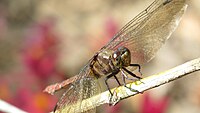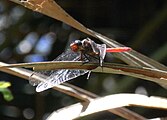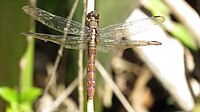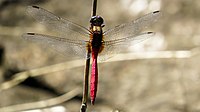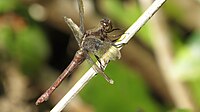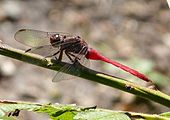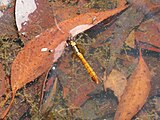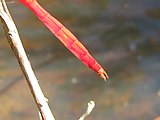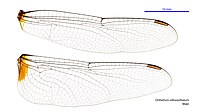Orthetrum villosovittatum
| Fiery skimmer | |
|---|---|

| |
| A male fiery skimmer, Cairns | |

| |
| Female | |
| Scientific classification | |
| Domain: | Eukaryota |
| Kingdom: | Animalia |
| Phylum: | Arthropoda |
| Class: | Insecta |
| Order: | Odonata |
| Infraorder: | Anisoptera |
| Family: | Libellulidae |
| Genus: | Orthetrum |
| Species: | O. villosovittatum
|
| Binomial name | |
| Orthetrum villosovittatum | |

| |
Orthetrum villosovittatum, known as the fiery skimmer,[3] is a species of dragonfly in the family Libellulidae.[4][5] Its range is from the Moluccas, New Guinea and neighbouring islands as well as Australia.[6] In Australia it is found in Victoria through eastern New South Wales and Queensland, north inland Queensland, Cape York Peninsula and north Northern Territory.[7] It is a common species through most of its range.
Orthetrum villosovittatum is a medium-sized dragonfly with a wingspan of 60–85 mm.[3] Mature males have dark greyish to greenish-brown thoraxes and red abdomens, with the abdomen constricted at segment four. Young males have an amber and black colouring. Females are ochre-coloured.
Orthetrum villosovittatum inhabits boggy seepages, streams and swamps.[3]
Gallery
[edit]-
Female face on
-
Male face on
-
Female
-
Male
-
Young males are an orange colour
-
Female side view
-
Male side view
-
Young male side view
-
Resting with wings held forward
-
Female looking to deposit her eggs in a pond
-
Male tail
-
Mating pair
-
Female wings
-
Male wings
References
[edit]- ^ Dow, R.A. (2017). "Orthetrum villosovittatum". IUCN Red List of Threatened Species. 2017: e.T83369839A83383913. doi:10.2305/IUCN.UK.2017-1.RLTS.T83369839A83383913.en. Retrieved 19 November 2021.
- ^ Brauer, F. (1868). "Neue und wenig bekannte vom Herrn Doct. Semper gesammelte Odonaten". Verhandlungen der Zoologisch-Botanischen Gesellschaft in Wien (in German). 18: 167–188 [167] – via Biodiversity Heritage Library.
- ^ a b c Theischinger, Gunther; Hawking, John (2007). The complete field guide to dragonflies of Australia. Collingwood, Vic.: CSIRO Publishing. ISBN 0-643-09073-8.
- ^ "Species Orthetrum villosovittatum (Brauer, 1868)". Australian Faunal Directory. Australian Biological Resources Study. 2012. Retrieved 1 March 2017.
- ^ Schorr, Martin; Paulson, Dennis. "World Odonata List". Slater Museum of Natural History. University of Puget Sound. Retrieved 1 March 2017.
- ^ Watson, J.A.L.; Theischinger, G.; Abbey, H.M. (1991). The Australian Dragonflies: A Guide to the Identification, Distributions and Habitats of Australian Odonata. Melbourne: CSIRO. p. 278. ISBN 0643051368.
- ^ Theischinger, Gunther; Endersby, Ian (2009). Identification Guide to the Australian Odonata (PDF). Department of Environment, Climate Change and Water NSW. p. 231. ISBN 978 1 74232 475 3.


